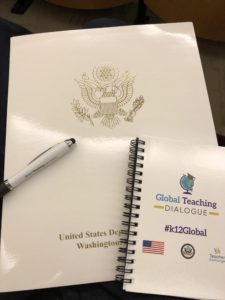Tips for Globalizing the Art Classroom
Teaching K-8 art in Philadelphia for the past ten years has been quite the ride. With all of the cultures, races, religions, and languages represented in my classroom daily, I knew that I needed to do more to provide a more inclusive and informative environment and curriculum. Where do you begin? I started with translating English words into Spanish and Mandarin on labels around the room, and I devoted marking periods for deep study on different countries. We culminated our lessons with a “stamp” in our passports to bid our countries farewell. It was exciting because I was learning too, and I wanted to learn more! So I looked for more opportunities – applying for travel fellowships and signing up for professional development that would help me grow to globalize my art classroom.
On July 27, 2018, I attended the Global Teaching Dialogue held at the US Department of State George Marshall Center in Washington, D.C. This annual professional development event held in D.C. every summer is designed to provide K-12 teachers an opportunity to learn from other education experts and US Department of State fellowship alumni about bringing the world into US classrooms.
The event began with a panel discussion of State Department alumni regarding their studies abroad and how they implemented their work into their classrooms upon their return to the United States. A brief breakout session followed where I attended a workshop providing tips for globalizing elementary classrooms, but the following tips can be adapted for all ages. I’ve combed through several of the suggestions to provide you with some real ideas to bring the world to your students!
Through books and literature:
- International Children’s Digital Library is online resource of children’s books from around the world, written in their original languages (and some available in other translations). The mission of the ICDL is to “support the world’s children in becoming effective members of the global community – who exhibit tolerance and respect for diverse cultures, languages and ideas.” Connect with your English language learners and teach about other cultures through these great books!
- Kitaab World advocates for representation of South Asian children’s literature in the mainstream. They work to spread awareness about South Asian culture, providing resources through “content, context, and community”. Extremely rich collection of books to purchase through the site, lesson plans, and other goodies.
Connect with your community:
- Connect with outside groups like universities, local cultural clubs, international students, parents, rotary clubs
- World Affairs Council of Philadelphia
- World Affairs Council of Pittsburgh
- World Affairs Council of Harrisburg
Connect and network through social media and websites:
- Connect on Twitter: try a chat and share what you’re doing in the classroom:
- #globaledchat
- #edchat
- #globalgoals
- Follow on Twitter:
- @AsiaSocietyEDU
- @NatGeoEducation
- @GlobalEdCon
- @TGC_IREX
- @IREXintl
- @iEARNUSA
- iEARN-USA (International Education and Resource Network) is a network to connect with other educators and students to collaborate and participate in global projects. There is a fee for membership, but if your district will not provide the funds, you should contact iEARN.
- Asia Society aims to educate all students for employability and citizenship in a global era. Online professional development and articles about teaching for global competence, as well other great resources.
Use technology:
- Flipgrid is a video discussion platform which can also be used to connect with other educators and students around the world. Use it for critiques, reflections, and discussions!
- Empatico is a free tool for teachers to connect their classroom with others around the world through live video and activities designed to foster meaningful connections among students. Available in English for classrooms with 7-11 year olds.
- Mystery Skype is a global guessing game that connects students with other classes around the world to learn about geography, culture, and the similarities and differences they have with others.
- Google Arts and Culture is an incredibly valuable tool with much to browse through. Virtual museum tours are a great way to visit museums around the world!
- ePals is a platform to connect with other classrooms for penpals and project collaborations.
Professional Development and Opportunities:
- Fulbright Teachers for Global Classrooms Program is a year-long professional development which teaches educators the skills to globalize their classrooms through an online course, global symposium held in Washington D.C., and a 2-3 week field experience abroad
- The Fulbright Distinguished Awards in Teaching Short-Term Program is for K-12 teachers to apply for grants to engage in collaborative projects for 2-6 weeks abroad. Participants work with schools, non-profit organizations, teacher training institutions, and other educational organizations.
- The German American Partnership Program (GAPP) Student Exchange is a school exchange program between America and Germany to learn more about our education systems and countries. Contact Stefanie Proessl (Stefanie.Proessl@goethe.de) for questions regarding getting yourself and a small group of students started!
These are just scratching the surface of what is available to teachers in order to globalize your classrooms. Are you already globalizing your class? Please share in the comments and add to this Google Sheet – PAEA Globalizing Your Art Classroom!


 D5 Creation
D5 Creation